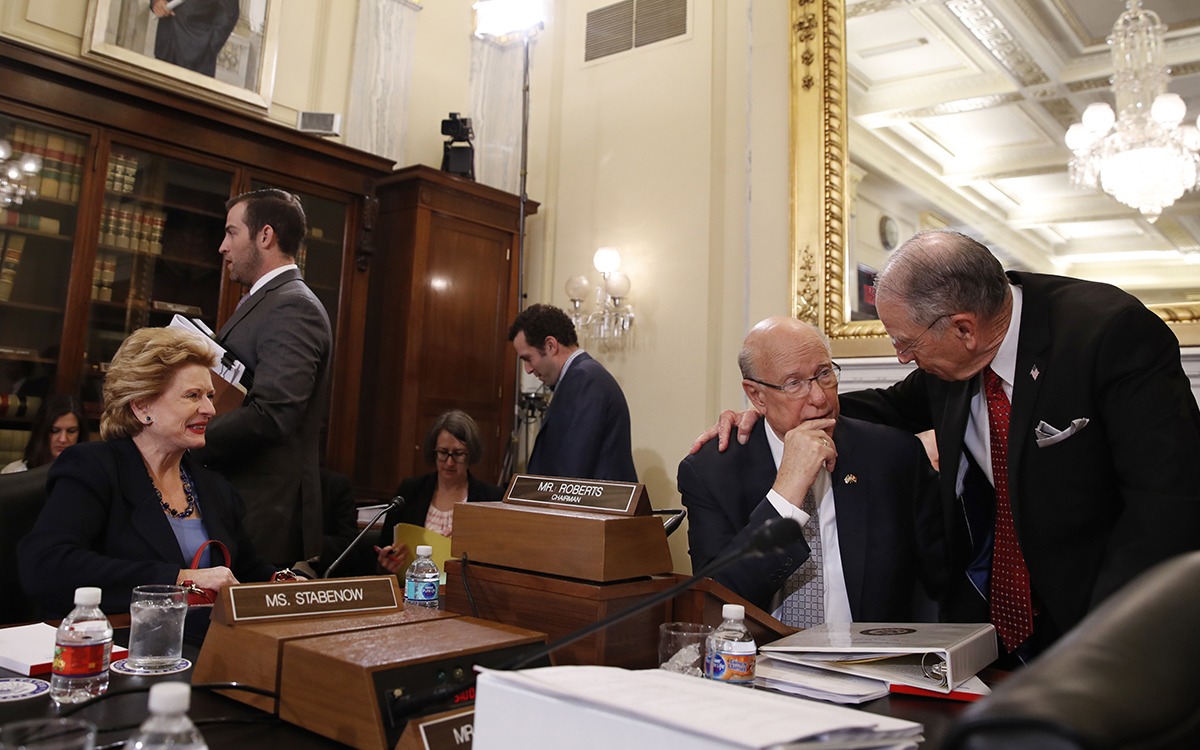What You Need to Know About the New Farm Bill
The next five years’ worth of food and farm policy isn’t perfect—but could’ve been a lot worse
The finish line is finally in sight. After months of negotiations, lawmakers in the House and Senate have reached agreement and signed off on the massive package of legislation that sets federal agricultural and food policy for the next five years. The farm bill—which lawmakers are referring to as the Agriculture Improvement Act of 2018—provides more than $400 billion to farms, conservation programs, food stamps, school lunches, and a host of other programs.
The bill is less draconian than the agribusiness-friendly draft bill that the House passed last April, which called for dramatic cuts to food stamps and to conservation programs.
Here are some key takeaways from the 807-page conference report.
Industrial hemp is officially legal.
The industrial production of marijuana’s nonpsychotropic cousin, hemp, an initiative championed by Republican Majority Leader Mitch McConnell, is formally legalized. On Monday evening, McConnell tweeted a video of himself signing the conference report with a hemp pen. Environmentalists everywhere, hopeful that hemp will lesson our economy’s reliance on the production of “dirty” cotton, are celebrating.
The new farm bill doesn’t make any significant changes to SNAP.
SNAP, also known as food stamps, is a food-benefits program that serves nearly 40 million low-income Americans and the biggest single expense in the farm bill. The most controversial provision in the House’s proposed bill would have imposed stringent work requirements that would have made it nearly impossible for people in rural areas where jobs are hard to come by to keep using SNAP. The final version of the farm bill made none of the changes proposed by the House, and also establishes a Produce Prescription Program, through which health-care providers can give low-income patients vouchers that can be exchanged for fresh fruits and vegetables.
The House was forced to drop nearly all of its demands for increased logging of national forests.
Negotiations got complicated in November, when the White House asked Congress to grant more authority to the Agriculture and Interior Departments to clear forests and other public lands (their justification for doing so: California’s deadly wildfires). The final text doesn’t significantly increase those agencies’ authority.
This did not turn into a pesticide free-for-all.
The House wanted to lower requirements for Clean Water Act permits to apply pesticides near certain waterways as well as requirements for agency collaboration on pesticides that might threaten endangered species. These did not make it into the final farm bill.
Conservation programs are safer than they were last summer.
The Conservation Stewardship Program (CSP) supports whole-farm, multiyear, holistic conservation management plans, and the House wanted to cut its budget entirely. Instead, the bill siphoned several hundred million dollars out of the program and funneled it into Environmental Quality Incentives Program (EQIP), which reimburses farmers for conservation-oriented farm projects.
Negotiators also created a conservation provision that didn't appear in earlier drafts of the farm bill: a way for farmers to enroll grassland that isn't eligible for commodity program payments into CSP and to allow grazing on it. It also includes a new Clean Lakes, Estuaries, and Rivers initiative, designed to support conservation buffers to benefit water quality.
Overall funding for conservation programs remained almost even with prior levels, at around $60 billion.
There’s now more funding for the Agricultural Conservation Easement Program.
This program provides funding to buy the development rights to agricultural land and wetlands so that senior farmers can retire without having to sell their land for residential, commercial, or industrial development, and so that farmland can remain affordable for beginning farmers. Funding for ACEP rose to $450 million per year (a $2 million annual increase over the current baseline). The bill grants $300 million in annual mandatory funding for the Regional Conservation Partnership Program, which addresses farmland loss and water quality and measures changes in phosphorus and sediment loss.
The new bill provides $50 million in annual funding for the flagship Organic Research and Extension Initiative through 2023.
That funding is more than double the current level. The bill also provides mandatory funding for the organic certification cost-share program, which incentivizes small and beginning farmers to transition to organic by relieving some of the costs associated with certification. In addition, the bill will fund the Organic Data Initiative, a USDA program designed to provide accurate market and production information for the organic industry and improve access to data that tracks the international organic trade.
Also: one section of the bill, the Organic Farmer and Consumer Protection Act, will require imported organic products to bear an electronic import certificate that is expected to help prevent organic fraud and create a more transparent marketplace.
Good news for greenhouses and city slickers.
The bill creates a new position at the USDA to assist urban and indoor farmers seeking to create or expand businesses. It also provides new research and development funding for greenhouse products.
There are some benefits for small but critical programs.
The Beginning Farmer and Rancher Development Program and the Outreach and Assistance for Socially Disadvantaged and Veteran Farmers and Ranchers Program are melded into a new Farming Opportunities Training and Outreach Program, which will fund organizations training the next generation of farmers. The Value-Added Producer Grant Program and the Farmers Market and Local Food Promotion Program become a new Local Agriculture Market Program, which will, for the first time, provide permanent funding to organizations working to improve local food infrastructure (think farmers' markets and regional food hubs).
The farm bill earmarks $30 million a year for a new program to combat animal diseases.
This includes a livestock vaccine bank that’s expected to protect against devastating outbreaks of maladies like foot-and-mouth disease.
The King (Amendement) is dead.
The much-maligned King Amendment (the darling of Iowa Republican representative Steve King), which threatened to nullify thousands of state and local laws that promote animal welfare and food and water safety, is not in the final farm bill.
Several new animal rights measures are in place.
Animal rights activists are also celebrating this version’s inclusion of the Pet and Women Safety Act, which extends current federal domestic violence protections to include pets and authorizes grant money to help domestic violence shelters accommodate pets.
The farm bill also includes a Parity in Animal Cruelty Enforcement Act, which ensures that current federal prohibitions on animal fighting activity are consistently applied in all US jurisdictions and territories, and a Dog and Cat Meat Trade Prohibition Act, which bans the domestic slaughter, trade, and import/export of dogs and cats for human consumption.

Ranking Member Senator Debbie Stabenow (D-Mich.), left, attends a meeting with Chairman Senator Pat Roberts (R-Kans.), center, as he speaks to Senator Chuck Grassley (R-Iowa) during a Senate Agriculture Committee meeting. | Photo by Jacquelyn Martin/AP
The bill has the support of US Secretary of Agriculture Sonny Perdue, who enthusiastically supports passage of the long-delayed package of food and farm legislation, and even Trump, who describes the farm bill as “in very good shape” and is expected to sign it any moment now. (The bill’s rare bipartisan support may stem in part from the fact that farmers across America are besieged by Trump’s trade war with China.)
Not everyone’s a fan of the final bill, though. Republican Senator Chuck Grassley of Iowa voted against the bill (which had the support of every Senate Democrat) because it allowed family farms to add extended family members—like cousins, nephews, and nieces—in order to increase the size of their farm subsidies, even if those relatives do not do any physical labor.
Oregon representative Earl Blumenauer, a Democrat and a champion of sustainable agriculture, also opposed it. “These days, bad outcomes that could’ve been worse count as victories,” he wrote on Twitter. “It’s time to change that dynamic.”
But still, when the votes came in, support for the new bill was significant. On Tuesday, the Senate passed the measure in an 87–13 vote. In a 386–47 vote on Wednesday, the House approved it too. In a time when political agreement is rare, that’s another takeaway worth noting.
 The Magazine of The Sierra Club
The Magazine of The Sierra Club




